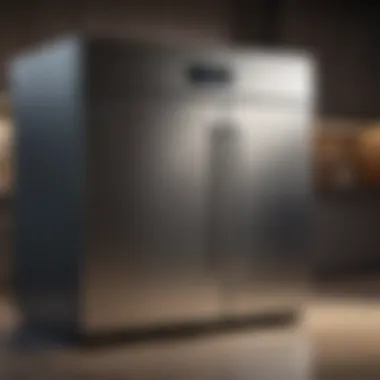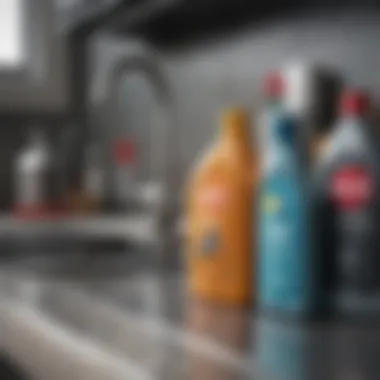Practical Tips for Cleaning Stainless Steel Stains


Intro
Stainless steel, with its sleek appearance and durable nature, has become a favored material in kitchens and bathrooms alike. But maintaining its luster can sometimes feel like an unwelcome chore. Stains often creep in, claiming victims among your favorite appliances and fixtures, leaving them looking less than pristine. This guide aims to arm you with effective, practical methods for tackling those pesky stains and restoring the shine.
Before diving into specific cleaning techniques, it’s crucial to grasp the various reasons behind these stains. Understanding what caused them in the first place can help in selecting the right cleaning method. From fingerprint smudges to water spots, different stains require tailored approaches.
By exploring simple yet effective cleaning solutions along with preventive measures, you'll be equipped to keep your stainless steel surfaces looking their very best. Whether you’re a real estate enthusiast eyeing properties or an interior design aficionado wanting to impress, having sparkling stainless steel can elevate the overall appeal of any space.
Let’s roll up our sleeves and explore the practicalities of stain removal!
Understanding Stainless Steel
In any discussion focused on cleaning stains off stainless steel, it is crucial to first appreciate the material itself. Understanding stainless steel helps in recognizing its unique properties and the very characteristics that allow it to withstand various conditions while also revealing its vulnerabilities. This foundational knowledge shapes the approach to keeping stainless steel surfaces free of stains.
Composition of Stainless Steel
Stainless steel is an alloy primarily made of iron, chromium, and, in many cases, nickel. The presence of chromium, typically at least 10.5%, is what gives stainless steel its corrosion-resistant properties. The chromium reacts with oxygen in the air to form a thin layer of chromium oxide on the surface, protecting the underlying metal from rust and stains. Depending on the grade and formulation, other elements like molybdenum or titanium may also be added to enhance specific qualities. This unique blend creates a material that not only looks sleek but also has a remarkable ability to resist tarnishing and staining under normal circumstances.
Characteristics of Stainless Steel
Stainless steel is favored in a multitude of settings—from kitchens to major appliances—because of its durability and sleek appearance. Some primary characteristics include:
- Corrosion Resistance: As mentioned, the alloy's composition prevents oxidation.
- Ease of Cleaning: Often, stains can be wiped away with minimal effort, especially with the right cleaners.
- Aesthetic Appeal: It maintains a shiny, modern look that fits various design themes.
- Temperature Resistance: Stainless steel can endure a wide range of temperatures, making it suitable for kitchen tasks.
These attributes contribute to its prevalence in both residential and commercial settings, underlining the importance of maintaining stainless steel items through proper cleaning methods.
Why Stains Occur on Stainless Steel
Despite its resilience, stainless steel is not entirely stain-proof. Understanding why these blemishes occur can help in selecting appropriate cleaning techniques. Some common causes include:
- Water: Water spots arise when fast-evaporating water leaves behind mineral deposits.
- Heat: Cooking can result in heat marks or discoloration on stainless steel surfaces due to temperature fluctuations and contact with hot pans.
- Fingers and Oils: Just like a magnet, your fingers carry oils and substances, which can leave unsightly marks on surfaces.
- Food Residue: Ingredients like oils or acidic substances can tarnish the sheen, leading to rust or unpleasant stains.
By grasping these fundamental reasons, cleaning becomes not just about removing stains but also about adopting preventive strategies that can help maintain the stain-resistant qualities of stainless steel over time.
Identifying Common Types of Stains
Stainless steel is celebrated for its sleek aesthetics and durability, but it is not impervious to staining. Understanding the common types of stains that can mar its surface is pivotal in maintaining its shiny appeal. This section provides an in-depth look at various staining culprits and equips you with the necessary insights to tackle them effectively.
Water Spots
Water spots are one of the most frequent offenders seen on stainless steel surfaces. These spots typically occur when water evaporates, leaving behind mineral deposits. They are particularly noticeable after washing or when using products that leave moisture behind.
To tackle water spots, a simple solution is to wipe the surface dry immediately after washing. If the spots have already set in, a mixture of equal parts water and vinegar can work wonders. Apply it to the affected area, let it sit for a bit, and then gently buff the surface with a soft cloth. This method not only removes the spots but also prevents future build-up.


Heat Marks
Heat marks often occur when pots and pans are placed on stainless steel countertops or surfaces without protective measures. These marks may look like dull spots or discoloration. Understanding their nature is essential, as they might require more than just a light cleaning.
Using a non-abrasive cleaner designed specifically for stainless steel can help regain the original finish. Alternatively, a baking soda paste can also be effective. Just mix baking soda with a bit of water to create a thick paste, apply it to the heat marks, let it sit for a few minutes, and buff it off with a clean cloth.
Fingerprints and Smudges
Fingerprints and smudges are an annoyance that almost everyone has experienced. They can be particularly frustrating, given how easily they can appear after handling stainless steel appliances. These unsightly marks often seem to multiply right before your eyes.
To remove fingerprints, a microfiber cloth dampened with a solution of warm water and a bit of dish soap can do the trick. Wipe in the grain of the steel to avoid scratching. If the stains persist, consider using a commercial stainless steel cleaner designed to minimize smudges.
Food and Oil Residue
Food particles and oil residues can cling to stainless steel surfaces, particularly in kitchen environments. Cooking spills often leave behind a grimy film or unsightly streaks. Recognizing this type of stain is simple. The residue can feel greasy or appear sticky.
Cleaning solutions like vinegar or dedicated food-grade cleaner can help to cut through this grease effectively. Alternatively, using a mix of baking soda with water can lift stubborn food remnants without damaging the stainless steel finish.
Rust Stains
Though stainless steel is resistant to rust, it can still develop rust stains under certain conditions, especially when exposed to moisture or corrosive substances. This type of staining is often a sign of neglect or improper care.
To address rust stains, a cleaning paste made from baking soda and water can be particularly useful. Gently scrub the area in a circular motion with a soft cloth. If stains prove more stubborn, a commercial rust remover could be necessary, but always ensure it's safe for stainless steel to avoid any unnecessary scratches or damage.
"Understanding the stains that can occur on your stainless steel surfaces is half the battle in maintaining their aesthetic appeal. A proactive approach can save both time and effort in upkeep."
Arming yourself with knowledge about these specific types of stains not only helps in applying the correct cleaning techniques but can also foster a diligent cleaning routine that will ultimately extend the lifespan of your stainless steel items.
Tools and Materials for Cleaning
Cleaning stainless steel isn't just about elbow grease. The right tools and materials can make a world of difference, turning a mundane chore into an efficient task. Using appropriate items not only enhances effectiveness but also protects your surfaces from scratches and unnecessary damage. This section will dive deep into the essentials you need to tackle those pesky stains.
Microfiber Cloths
One of the unsung heroes in the realm of cleaning is the humble microfiber cloth. These cloths are made from fine synthetic fibers, which makes them incredibly effective at lifting and trapping dirt without scratching your stainless steel surfaces. The beauty of microfiber lies in its dual capabilities: it excels in both dry and wet cleaning. When using it dry, it can easily gather dust; when dampened, it can remove stubborn stains and smudges with a simple swipe. Just make sure you wash them regularly to keep them fresh and effective.
Non-Abrasive Cleaners
When it comes to cleaning solutions, opting for non-abrasive cleaners is crucial for maintaining the integrity of stainless steel. These cleansers are formulated to remove grime without scratching or dulling the surface. Look for products that are labeled for stainless steel; they often contain mild detergents or natural ingredients that won't harm the surface. Plus, many of these cleaners come in spray bottles, making it easy to apply and allowing for a more convenient cleaning experience. Always remember to read the labels and ensure the product aligns with your cleaning goals.
Baking Soda and Water Paste
A classic combination that's stood the test of time is baking soda mixed with water. This natural powerhouse not only fights stains but also acts as a gentle abrasive. To whip up your cleaning paste, mix equal parts of baking soda and water until you reach a spreadable consistency. Apply this mixture to the stained area and let it sit for a few minutes. Afterwards, using a cloth, you can scrub in the direction of the grain. It’s like a little workout for your surfaces!


Vinegar and Oil Solution
If you fancy a more DIY approach, look no further than a vinegar and oil solution. This combination doesn’t just cleanse; it also leaves your stainless steel looking polished. Vinegar acts as a natural degreaser, while the oil helps to seal in a shine. Mix equal parts of vinegar and olive oil, apply it to your cloth, and use it to wipe down the surface. It’s an eco-friendly solution that keeps your stainless steel gleaming like new. Just be cautious with the amount of vinegar, as too much acid can be counterproductive at times.
Commercial Stainless Steel Cleaners
For those who prefer a more hassle-free method, commercial stainless steel cleaners are widely available and designed specifically for this purpose. These products often come in convenient sprays or wipes and are formulated to target a variety of stains while leaving behind a streak-free finish. While these cleaners can be a bit pricier compared to DIY solutions, they are usually quite effective and easy to use.
"Investing in the right tools and materials not only enhances your cleaning experience but prolongs the life of your stainless steel surfaces."
Step-by-Step Cleaning Techniques
When it comes to maintaining the gleam of stainless steel, knowing the right method can make a world of difference. Stains, whether they're from fingerprints or rust, can be quite the eyesore. Establishing a systematic approach not only helps in effectively tackling different tough stains but also aids in preserving the inherent sheen that stainless steel offers. A step-by-step cleaning guide equips you with the knowledge to address specific types of stains suited to their unique needs, preventing further damage while enhancing longevity.
General Cleaning Process
To start with a general cleaning process, gather your materials first. You’ll mainly need some microfiber cloths along with your chosen cleaning solution. Mix a few drops of mild dish soap with warm water in a bowl. This solution will help lift light dirt and grime.
- Dampen the cloth: Soak a clean microfiber cloth in the soapy water and wring it out until it’s just damp, not dripping wet.
- Wipe the surface: Gently wipe the stainless steel surface in the direction of the grain. This direction is crucial because it prevents scratches and enhances shine.
- Rinse and dry: After wiping down the surface, rinse the cloth thoroughly in clean water, wring it out again, and wipe the area to remove any soap residue. Follow this with a dry cloth to ensure there are no water spots left behind.
Taking these simple steps can typically restore shine to your stainless steel without the need for harsh chemicals.
Removing Fingerprints and Smudges
Fingerprints and smudges are common nuisances that diminish the polished appearance of stainless steel. To tackle these, you can use undiluted vinegar or a commercial glass cleaner.
- Apply the cleaner: Spray the cleaner directly onto the affected area. If using vinegar, soak a cloth in vinegar and apply it directly to the stains.
- Wipe with care: With a dry microfiber cloth, wipe the surface in the direction of the grain. This not only ensures effective removal but also polishes the surface at the same time.
- Final rinse: Again, rinse with a damp cloth and dry immediately to leave a streak-free finish.
This method will keep surfaces neat and free from unsightly marks, maintaining the elegance of your appliances.
Addressing Water Spots
To deal with water spots, you can turn to natural solutions which are often just lying around the house. Lemon juice acts wonderfully against mineral deposits.
- Create the mixture: Combine equal parts of lemon juice and water. This acidic solution works wonders on stubborn spots.
- Apply carefully: Use a soft cloth dipped in the solution and gently rub it over the spots.
- Wipe clean: Wait a few minutes and then wipe the area with a clean, damp cloth, followed by drying it off.
This technique not only removes the spots effectively but leaves a fresh scent too.
Treating Heat Marks
Heat marks occur mainly around areas exposed to cooking or hot items. For these stains, the solution may require a bit more elbow grease.
- Baking soda paste: Combine baking soda with a splash of water to make a paste. This mild abrasive will help lift tough stains.
- Application: Apply the paste with a soft cloth directly on the heat marks, gently rubbing in a circular motion.
- Wipe off: After a few minutes, rinse the area to remove the residue and dry thoroughly.


This method can truly bring the surfaces back to life, making sure you don’t have to settle for dull-looking appliances.
Dealing with Rust Stains
Rust stains can be particularly tricky, often requiring more serious action. A unique mixture of baking soda and water provides a great solution.
- Prepare the paste: Similar to addressing heat marks, you'll want to create a thick paste with baking soda and a few drops of water.
- Application method: Rub the paste over the rust stains and let it sit for 10 to 15 minutes. The baking soda will start to dissolve the rust.
- Scrub gently: Use a soft brush or cloth to scrub the area gently, followed by rinsing and drying.
Using this method offers a dual benefit: you not only remove the stains, but also prevent further corrosion from forming, which is essential for longevity.
By employing these step-by-step cleaning techniques, you’re not just restoring surfaces, but ensuring a longer life for your stainless steel fixtures and appliances. Remember, a little care goes a long way!
Preventing Future Stains
Stainless steel is often heralded for its resilience and sleek appearance, but even the most durable surfaces can fall victim to stains. This section focuses on preventive measures that can save you the headaches of dealing with marks later on. Maintaining a pristine facade not only enhances the aesthetic value of your fixtures but also prolongs their lifespan. Leaving stains to fester can lead to more serious blemishes that compromise both functionality and beauty. Establishing a consistent cleaning routine, understanding storage practices, and selecting appropriate products are all critical elements in preventing future stains.
Regular Maintenance Practices
Regular maintenance is the bedrock of any effective cleaning strategy. It requires a commitment to routine care that can keep your stainless steel looking brand new.
- Daily wipe downs: Just a simple swipe with a damp cloth can remove any moisture or residues that might lead to spots or rust. This takes just a few minutes and pays dividends over time.
- Weekly deep cleans: Every week, set aside time for a more thorough cleaning session. Use a non-abrasive cleaner and a soft cloth to address any build-up before it sets in. This will help maintain that signature shine typically associated with high-quality stainless steel.
- Avoid harsh cleaning agents: Products with chlorine or ammonia can cause damage. Instead, opt for milder solutions or homemade remedies with vinegar or baking soda.
Proper Storage of Stainless Steel Items
The way you store stainless steel items can have a dramatic impact on their cleanliness. Ensuring they are kept in suitable conditions can prevent unnecessary exposure to stains.
- Keep items dry: Moisture can contribute to rust and spots. Store items in dry areas, preferably in cabinets, where not only will they stay clean but also be protected from accidental spills.
- Use padded storage options: When stacking stainless steel pots and pans, use liners or cloths to prevent scratching and keep them safe from direct contact that could lead to marks.
- Avoid overcrowding: Storing too many items together can lead to scratches and scuffs. Space things out, allowing air circulation to prevent moisture retention.
Choosing the Right Cleaning Products
Selecting the right cleaning products is pivotal in safeguarding your stainless steel surfaces. Not all cleaners are created equal, and some can cause more harm than good.
- Look for non-abrasive options: Products that are labeled as non-abrasive are usually safe for stainless steel. Check reviews and recommendations to find the best options suited for your needs.
- Homemade solutions: Often, base ingredients like baking soda and vinegar can effectively clean many types of stains while remaining gentle on your surfaces. Plus, they’re usually far less costly than commercial cleaners.
- Avoid using steel wool or scrubbing pads: These can scratch the surface, making it more susceptible to collecting dirt and stains. Use soft cloths or sponges instead.
Always remember, diligence in both maintenance and storage goes a long way. Simple habits can forge a resilient defense against stains and keep your stainless steel shining bright into the future.
Finale
Cleaning stainless steel surfaces can feel like an uphill battle at times, but this article has emphasized that it doesn’t have to be. Understanding the principles behind effective cleaning methods can transform tarnished appliances back to their radiant glory. This becomes especially essential for kitchen fixtures, where cleanliness directly contributes to food safety, and for aesthetic appeal, particularly in open-concept spaces.
Recap of Key Techniques
- Know Your Stains: Identifying the type of stain is crucial. Water spots, heat marks, and fingerprints all necessitate different approaches. For instance, while a vinegar and oil solution might do wonders for grease stains, water spots may require a simple but thorough wipe down with a microfiber cloth.
- Choose the Right Tools: Using the appropriate tools can make all the difference in maintenance. Non-abrasive cleaners and microfiber cloths are gentle on the surface yet effective in drawing out dirt and stains without scratching. Baking soda mixes or adhesives can create a paste that tackles tougher stains without causing damage.
- Establish a Regular Cleaning Routine: Proactive care is the best strategy. Regularly wiping down surfaces helps prevent buildup, ensuring stainless steel retains its sleek look long-term.
- Preventive Measures: Finally, understanding how environmental factors contribute to stains can inform better maintenance choices like proper storage and the right products.
Final Thoughts on Maintenance
Maintaining stainless steel is not just about aesthetics; it’s about prolonging life and integrity of the items. Scheduling routine checks and developing a habit of cleaning soon after using items goes a long way.
- Stay Proactive: Treat stains as they appear, never letting them settle in, and you’ll keep your surfaces gleaming.
- Seek Professional Products: Sometimes, investing in high-quality commercial cleaners is worth the expense, especially in high-traffic areas. Always read labels and avoid harsh chemicals that could strip the steel's sheen.
- Stay Educated and Informed: Keeping up to date with the latest cleaning tips, products, and techniques through forums and informational websites can enrich your cleaning practices. Recommendations from other homeowners on platforms like reddit.com can also shed light on useful tricks worth trying.
Achieving and maintaining that shiny finish on stainless steel isn’t insurmountable. It requires understanding, technique, and a bit of routine effort. As a final nugget of wisdom, remember that satisfied stainless steel surfaces aren’t just visually appealing but are also markers of a meticulous, well-managed home.







